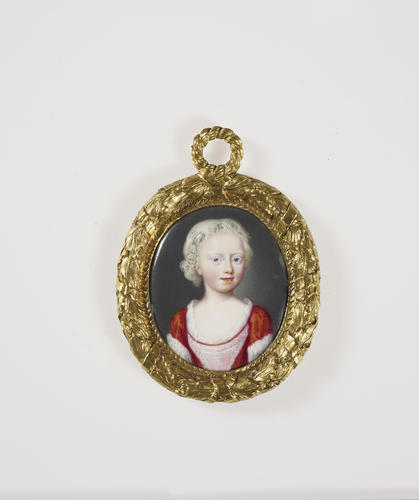-
1 of 253523 objects
Frederick, Prince of Wales (1707-1751) c.1714
Enamel | 3.4 x 2.7 cm (sight) | RCIN 421804
-
This miniature shows Frederick as a child of about seven and painted from life. Charles Boit was Enamel Painter to the Court until Queen Anne died in 1714, when he moved to France. Much of his work was taken over by his pupil, Christian Frederick Zincke (1683/4-1767), and this miniature has traditionally been ascribed to him. It must, together with two other enamels of Princess Anne and Princess Amelia (Royal Collection, RCIN 421805 and 421806), be the earliest examples of Zincke's work in the Royal Collection.
Frederick Louis was born in Hanover, the first child of George Augustus, Electoral Prince of Hanover, who later became George II, King of Great Britain and Ireland (1683–1760). When his grandfather was proclaimed King in 1714, most of the family moved to England but Frederick, aged seven, was left behind in Hanover as a representative of the Electoral family. Thus, unless Zincke made a previously unrecorded visit to Hanover, this miniature cannot have been painted from life. It must derive from an oil painting brought to London by the Prince's parents, but no longer recorded.
The artist, Zincke, was born in Dresden, the son of a goldsmith. He settled in England in 1706 and studied enamel painting under Charles Boit. He developed a thriving business, at first copying portraits by Sir Peter Lely and Sir Godfrey Kneller, then painting from life. He worked extensively for the royal family and, perhaps because he spoke German, was one of the few artists George II could tolerate. By 1730 he was well established at court and in February 1732, was appointed Cabinet Painter to Frederick, Prince of Wales. His eyesight began to fail, however, and he lamented: 'I find my Eyes scarce Capable of seeing them fine strokes'. By 1752 he had retired and only painted for his own pleasure. George II commented that Zincke's portraits were 'beautiful and like'.Provenance
Probably in the Royal Collection since they were first painted; first certainly recorded in 1858
-
Medium and techniques
Enamel
Measurements
3.4 x 2.7 cm (sight)
4.4 x 4.1 cm (frame, external)
Category
Object type(s)
